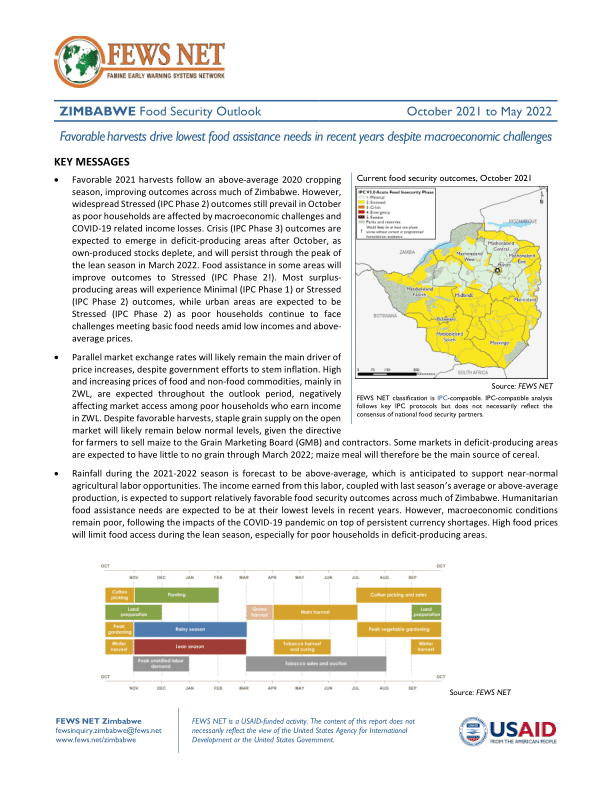Source: Zimbabwe: Food Security Outlook, October 2021 to May 2022 – Zimbabwe | ReliefWeb
Favorable harvests drive lowest food assistance needs in recent years despite macroeconomic challenges
KEY MESSAGES
- Favorable 2021 harvests follow an above-average 2020 cropping season, improving outcomes across much of Zimbabwe. However, widespread Stressed (IPC Phase 2) outcomes still prevail in October as poor households are affected by macroeconomic challenges and COVID-19 related income losses. Crisis (IPC Phase 3) outcomes are expected to emerge in deficit-producing areas after October, as own-produced stocks deplete, and will persist through the peak of the lean season in March 2022. Food assistance in some areas will improve outcomes to Stressed (IPC Phase 2!). Most surplus- producing areas will experience Minimal (IPC Phase 1) or Stressed (IPC Phase 2) outcomes, while urban areas are expected to be Stressed (IPC Phase 2) as poor households continue to face challenges meeting basic food needs amid low incomes and above- average prices.
- Parallel market exchange rates will likely remain the main driver of price increases, despite government efforts to stem inflation. High and increasing prices of food and non-food commodities, mainly in ZWL, are expected throughout the outlook period, negatively affecting market access among poor households who earn income in ZWL. Despite favorable harvests, staple grain supply on the open market will likely remain below normal levels, given the directive for farmers to sell maize to the Grain Marketing Board (GMB) and contractors. Some markets in deficit-producing areas are expected to have little to no grain through March 2022; maize meal will therefore be the main source of cereal.
- Rainfall during the 2021-2022 season is forecast to be above-average, which is anticipated to support near-normal agricultural labor opportunities. The income earned from this labor, coupled with last season’s average or above-average production, is expected to support relatively favorable food security outcomes across much of Zimbabwe. Humanitarian food assistance needs are expected to be at their lowest levels in recent years. However, macroeconomic conditions remain poor, following the impacts of the COVID-19 pandemic on top of persistent currency shortages. High food prices will limit food access during the lean season, especially for poor households in deficit-producing areas.

COMMENTS